Understanding and Leading Change: Nokia and Tesco Case Study Report
VerifiedAdded on 2020/12/31
|18
|6141
|311
Report
AI Summary
This report provides a comprehensive analysis of change management strategies employed by Nokia and Tesco, focusing on the impact of internal and external drivers of change. The report explores how these companies adapted their strategies and operations in response to evolving customer needs and technological advancements. It examines the organizational structure, technology, marketing, HR, and production changes within both companies. Furthermore, the report details the different drivers of change, the impact of change on leadership, team, and individual behaviors, and measures to minimize negative impacts, including the application of the PDCA cycle. The report also evaluates organizational responses to change using systems theory and continuous improvement models, specifically Kaizen. The analysis aims to provide insights into effective change management practices and strategies for adapting to market dynamics and technological advancements, offering valuable lessons for leadership and organizational development.
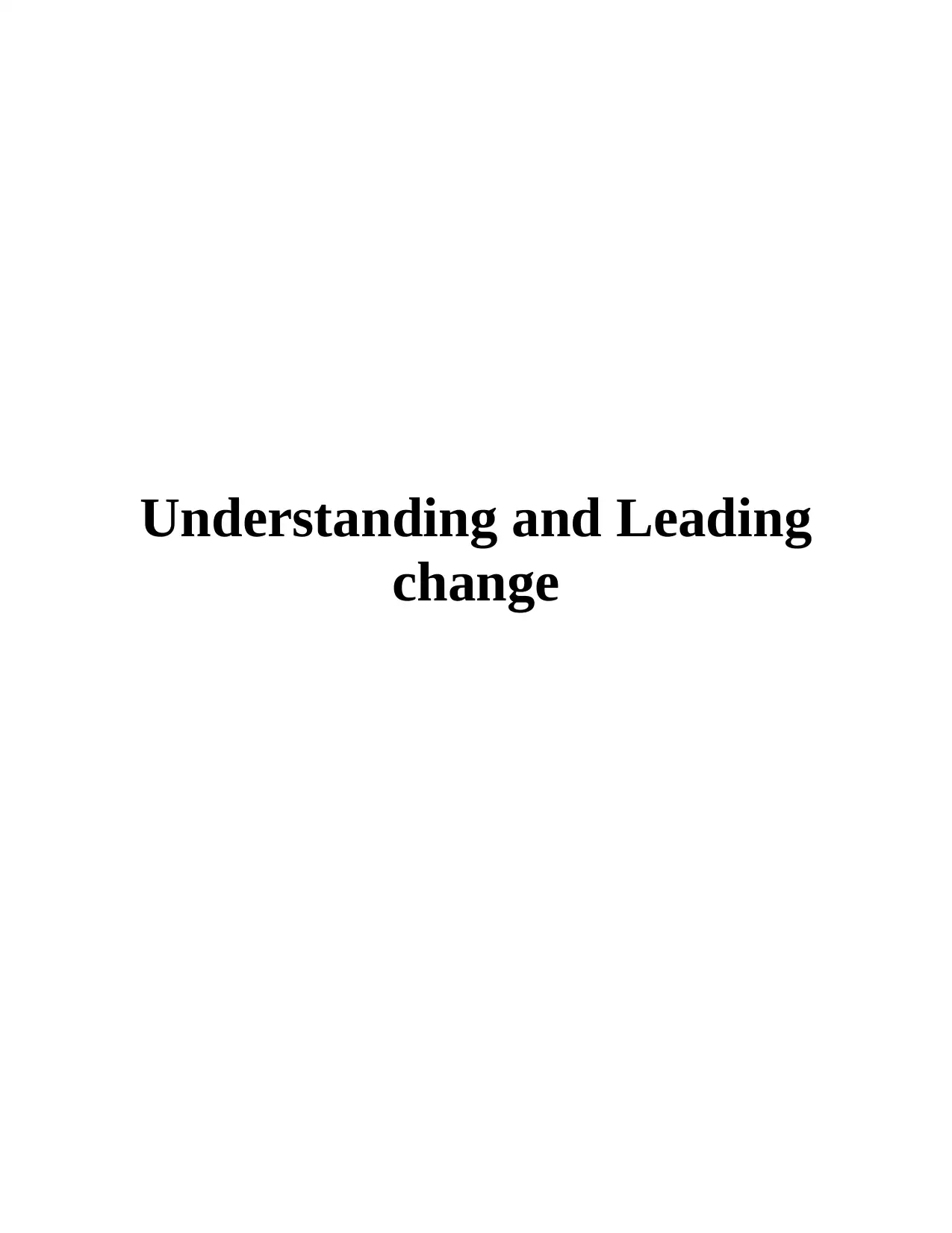
Understanding and Leading
change
change
Paraphrase This Document
Need a fresh take? Get an instant paraphrase of this document with our AI Paraphraser
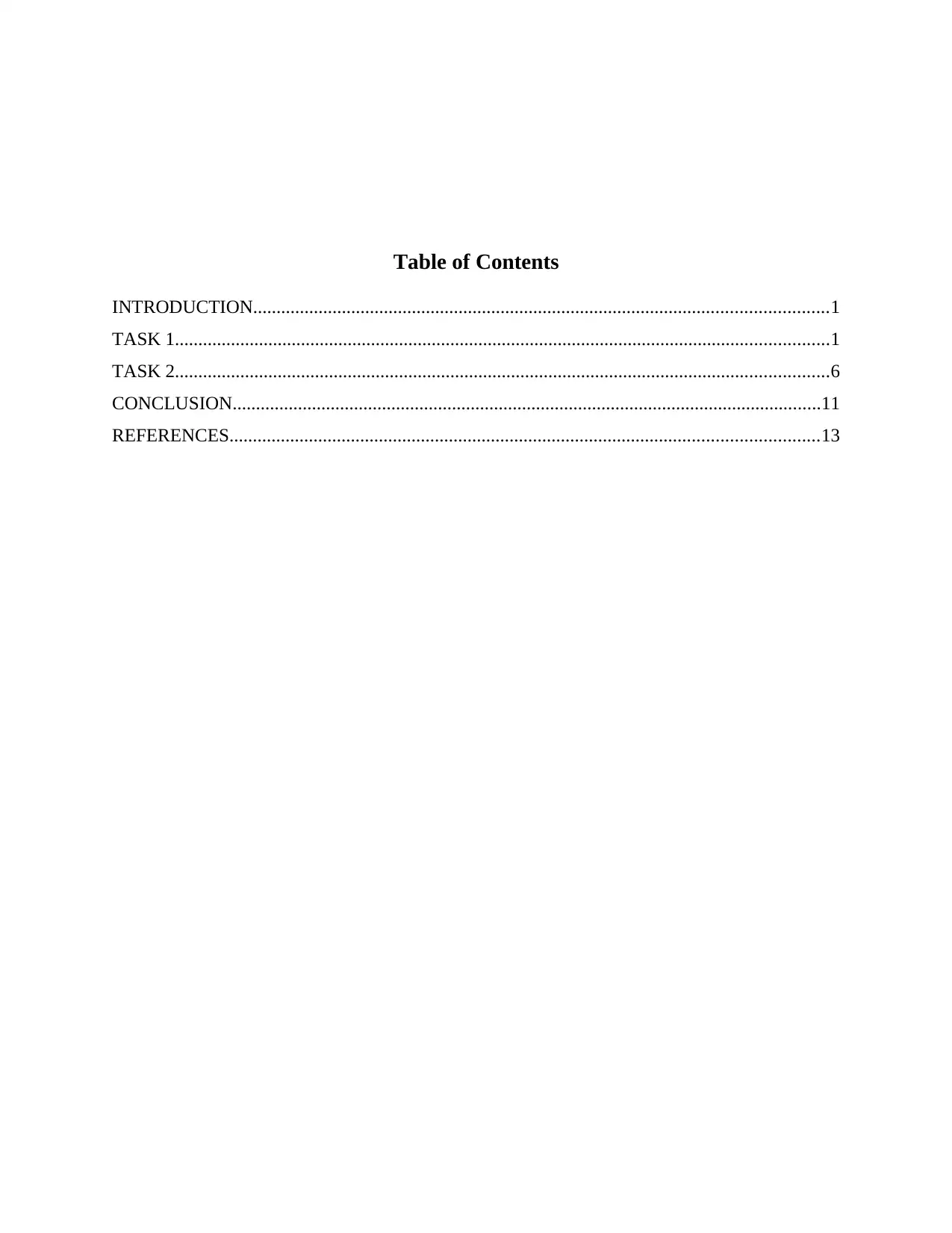
Table of Contents
INTRODUCTION...........................................................................................................................1
TASK 1............................................................................................................................................1
TASK 2............................................................................................................................................6
CONCLUSION..............................................................................................................................11
REFERENCES..............................................................................................................................13
INTRODUCTION...........................................................................................................................1
TASK 1............................................................................................................................................1
TASK 2............................................................................................................................................6
CONCLUSION..............................................................................................................................11
REFERENCES..............................................................................................................................13
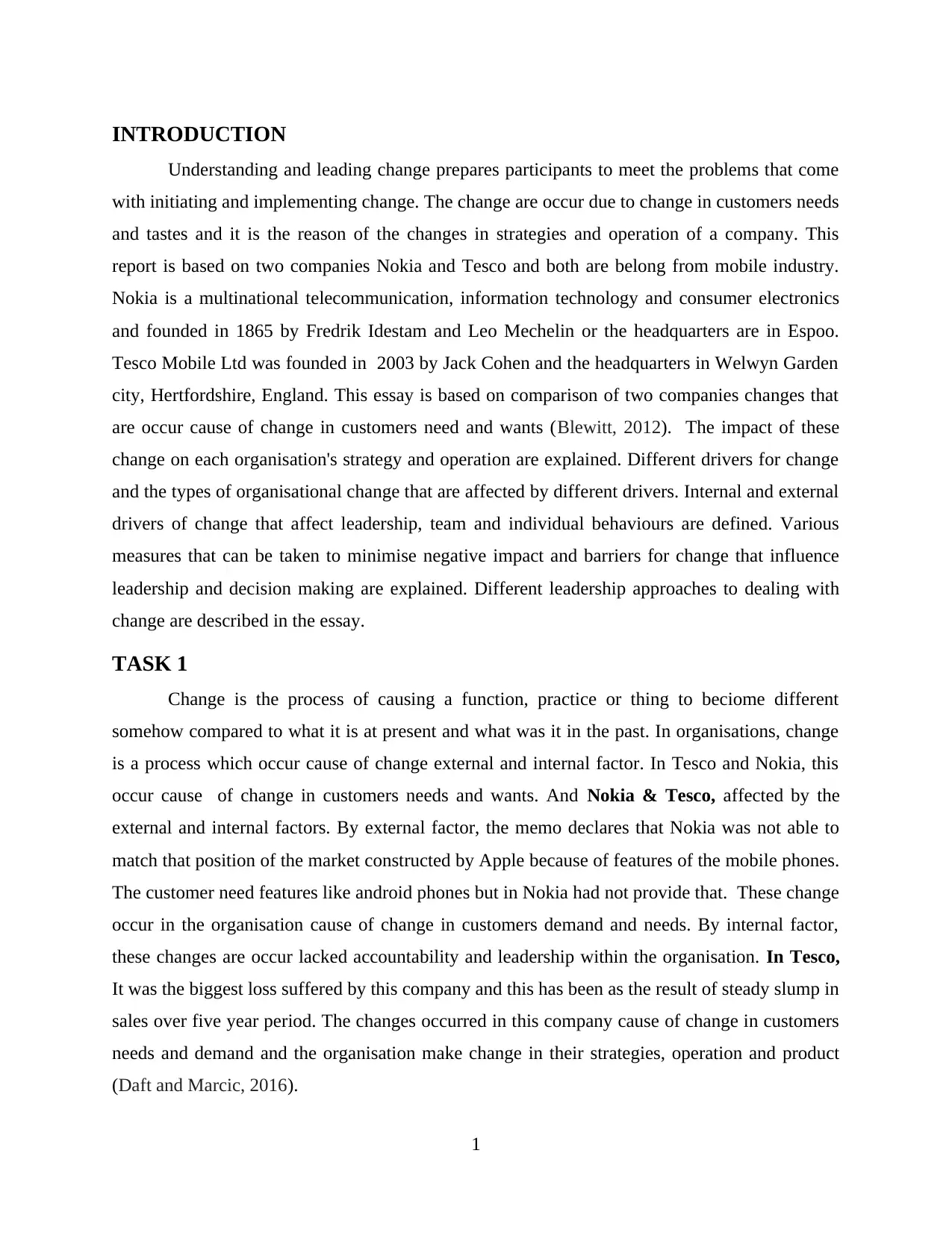
INTRODUCTION
Understanding and leading change prepares participants to meet the problems that come
with initiating and implementing change. The change are occur due to change in customers needs
and tastes and it is the reason of the changes in strategies and operation of a company. This
report is based on two companies Nokia and Tesco and both are belong from mobile industry.
Nokia is a multinational telecommunication, information technology and consumer electronics
and founded in 1865 by Fredrik Idestam and Leo Mechelin or the headquarters are in Espoo.
Tesco Mobile Ltd was founded in 2003 by Jack Cohen and the headquarters in Welwyn Garden
city, Hertfordshire, England. This essay is based on comparison of two companies changes that
are occur cause of change in customers need and wants (Blewitt, 2012). The impact of these
change on each organisation's strategy and operation are explained. Different drivers for change
and the types of organisational change that are affected by different drivers. Internal and external
drivers of change that affect leadership, team and individual behaviours are defined. Various
measures that can be taken to minimise negative impact and barriers for change that influence
leadership and decision making are explained. Different leadership approaches to dealing with
change are described in the essay.
TASK 1
Change is the process of causing a function, practice or thing to beciome different
somehow compared to what it is at present and what was it in the past. In organisations, change
is a process which occur cause of change external and internal factor. In Tesco and Nokia, this
occur cause of change in customers needs and wants. And Nokia & Tesco, affected by the
external and internal factors. By external factor, the memo declares that Nokia was not able to
match that position of the market constructed by Apple because of features of the mobile phones.
The customer need features like android phones but in Nokia had not provide that. These change
occur in the organisation cause of change in customers demand and needs. By internal factor,
these changes are occur lacked accountability and leadership within the organisation. In Tesco,
It was the biggest loss suffered by this company and this has been as the result of steady slump in
sales over five year period. The changes occurred in this company cause of change in customers
needs and demand and the organisation make change in their strategies, operation and product
(Daft and Marcic, 2016).
1
Understanding and leading change prepares participants to meet the problems that come
with initiating and implementing change. The change are occur due to change in customers needs
and tastes and it is the reason of the changes in strategies and operation of a company. This
report is based on two companies Nokia and Tesco and both are belong from mobile industry.
Nokia is a multinational telecommunication, information technology and consumer electronics
and founded in 1865 by Fredrik Idestam and Leo Mechelin or the headquarters are in Espoo.
Tesco Mobile Ltd was founded in 2003 by Jack Cohen and the headquarters in Welwyn Garden
city, Hertfordshire, England. This essay is based on comparison of two companies changes that
are occur cause of change in customers need and wants (Blewitt, 2012). The impact of these
change on each organisation's strategy and operation are explained. Different drivers for change
and the types of organisational change that are affected by different drivers. Internal and external
drivers of change that affect leadership, team and individual behaviours are defined. Various
measures that can be taken to minimise negative impact and barriers for change that influence
leadership and decision making are explained. Different leadership approaches to dealing with
change are described in the essay.
TASK 1
Change is the process of causing a function, practice or thing to beciome different
somehow compared to what it is at present and what was it in the past. In organisations, change
is a process which occur cause of change external and internal factor. In Tesco and Nokia, this
occur cause of change in customers needs and wants. And Nokia & Tesco, affected by the
external and internal factors. By external factor, the memo declares that Nokia was not able to
match that position of the market constructed by Apple because of features of the mobile phones.
The customer need features like android phones but in Nokia had not provide that. These change
occur in the organisation cause of change in customers demand and needs. By internal factor,
these changes are occur lacked accountability and leadership within the organisation. In Tesco,
It was the biggest loss suffered by this company and this has been as the result of steady slump in
sales over five year period. The changes occurred in this company cause of change in customers
needs and demand and the organisation make change in their strategies, operation and product
(Daft and Marcic, 2016).
1
⊘ This is a preview!⊘
Do you want full access?
Subscribe today to unlock all pages.

Trusted by 1+ million students worldwide
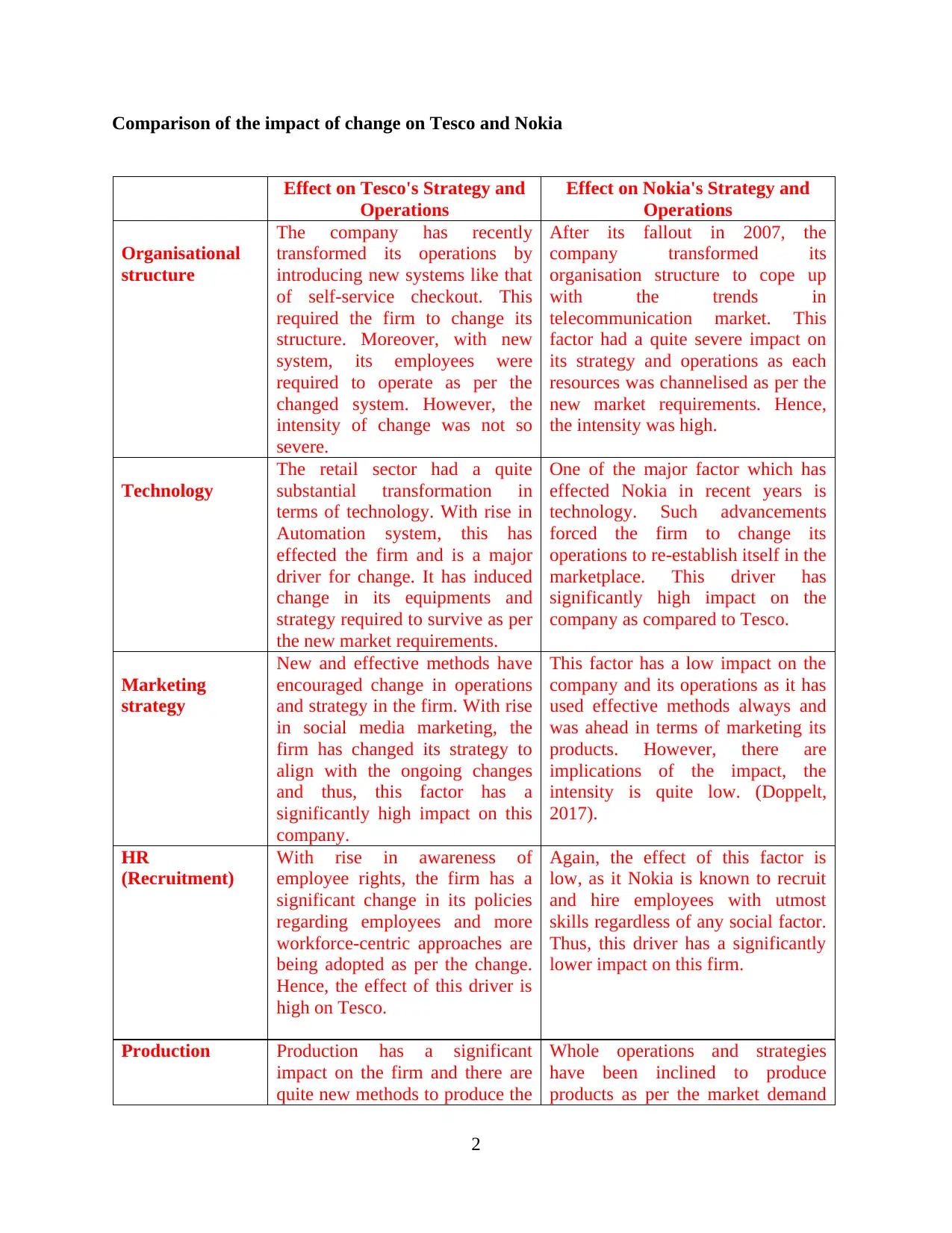
Comparison of the impact of change on Tesco and Nokia
Effect on Tesco's Strategy and
Operations
Effect on Nokia's Strategy and
Operations
Organisational
structure
The company has recently
transformed its operations by
introducing new systems like that
of self-service checkout. This
required the firm to change its
structure. Moreover, with new
system, its employees were
required to operate as per the
changed system. However, the
intensity of change was not so
severe.
After its fallout in 2007, the
company transformed its
organisation structure to cope up
with the trends in
telecommunication market. This
factor had a quite severe impact on
its strategy and operations as each
resources was channelised as per the
new market requirements. Hence,
the intensity was high.
Technology
The retail sector had a quite
substantial transformation in
terms of technology. With rise in
Automation system, this has
effected the firm and is a major
driver for change. It has induced
change in its equipments and
strategy required to survive as per
the new market requirements.
One of the major factor which has
effected Nokia in recent years is
technology. Such advancements
forced the firm to change its
operations to re-establish itself in the
marketplace. This driver has
significantly high impact on the
company as compared to Tesco.
Marketing
strategy
New and effective methods have
encouraged change in operations
and strategy in the firm. With rise
in social media marketing, the
firm has changed its strategy to
align with the ongoing changes
and thus, this factor has a
significantly high impact on this
company.
This factor has a low impact on the
company and its operations as it has
used effective methods always and
was ahead in terms of marketing its
products. However, there are
implications of the impact, the
intensity is quite low. (Doppelt,
2017).
HR
(Recruitment)
With rise in awareness of
employee rights, the firm has a
significant change in its policies
regarding employees and more
workforce-centric approaches are
being adopted as per the change.
Hence, the effect of this driver is
high on Tesco.
Again, the effect of this factor is
low, as it Nokia is known to recruit
and hire employees with utmost
skills regardless of any social factor.
Thus, this driver has a significantly
lower impact on this firm.
Production Production has a significant
impact on the firm and there are
quite new methods to produce the
Whole operations and strategies
have been inclined to produce
products as per the market demand
2
Effect on Tesco's Strategy and
Operations
Effect on Nokia's Strategy and
Operations
Organisational
structure
The company has recently
transformed its operations by
introducing new systems like that
of self-service checkout. This
required the firm to change its
structure. Moreover, with new
system, its employees were
required to operate as per the
changed system. However, the
intensity of change was not so
severe.
After its fallout in 2007, the
company transformed its
organisation structure to cope up
with the trends in
telecommunication market. This
factor had a quite severe impact on
its strategy and operations as each
resources was channelised as per the
new market requirements. Hence,
the intensity was high.
Technology
The retail sector had a quite
substantial transformation in
terms of technology. With rise in
Automation system, this has
effected the firm and is a major
driver for change. It has induced
change in its equipments and
strategy required to survive as per
the new market requirements.
One of the major factor which has
effected Nokia in recent years is
technology. Such advancements
forced the firm to change its
operations to re-establish itself in the
marketplace. This driver has
significantly high impact on the
company as compared to Tesco.
Marketing
strategy
New and effective methods have
encouraged change in operations
and strategy in the firm. With rise
in social media marketing, the
firm has changed its strategy to
align with the ongoing changes
and thus, this factor has a
significantly high impact on this
company.
This factor has a low impact on the
company and its operations as it has
used effective methods always and
was ahead in terms of marketing its
products. However, there are
implications of the impact, the
intensity is quite low. (Doppelt,
2017).
HR
(Recruitment)
With rise in awareness of
employee rights, the firm has a
significant change in its policies
regarding employees and more
workforce-centric approaches are
being adopted as per the change.
Hence, the effect of this driver is
high on Tesco.
Again, the effect of this factor is
low, as it Nokia is known to recruit
and hire employees with utmost
skills regardless of any social factor.
Thus, this driver has a significantly
lower impact on this firm.
Production Production has a significant
impact on the firm and there are
quite new methods to produce the
Whole operations and strategies
have been inclined to produce
products as per the market demand
2
Paraphrase This Document
Need a fresh take? Get an instant paraphrase of this document with our AI Paraphraser
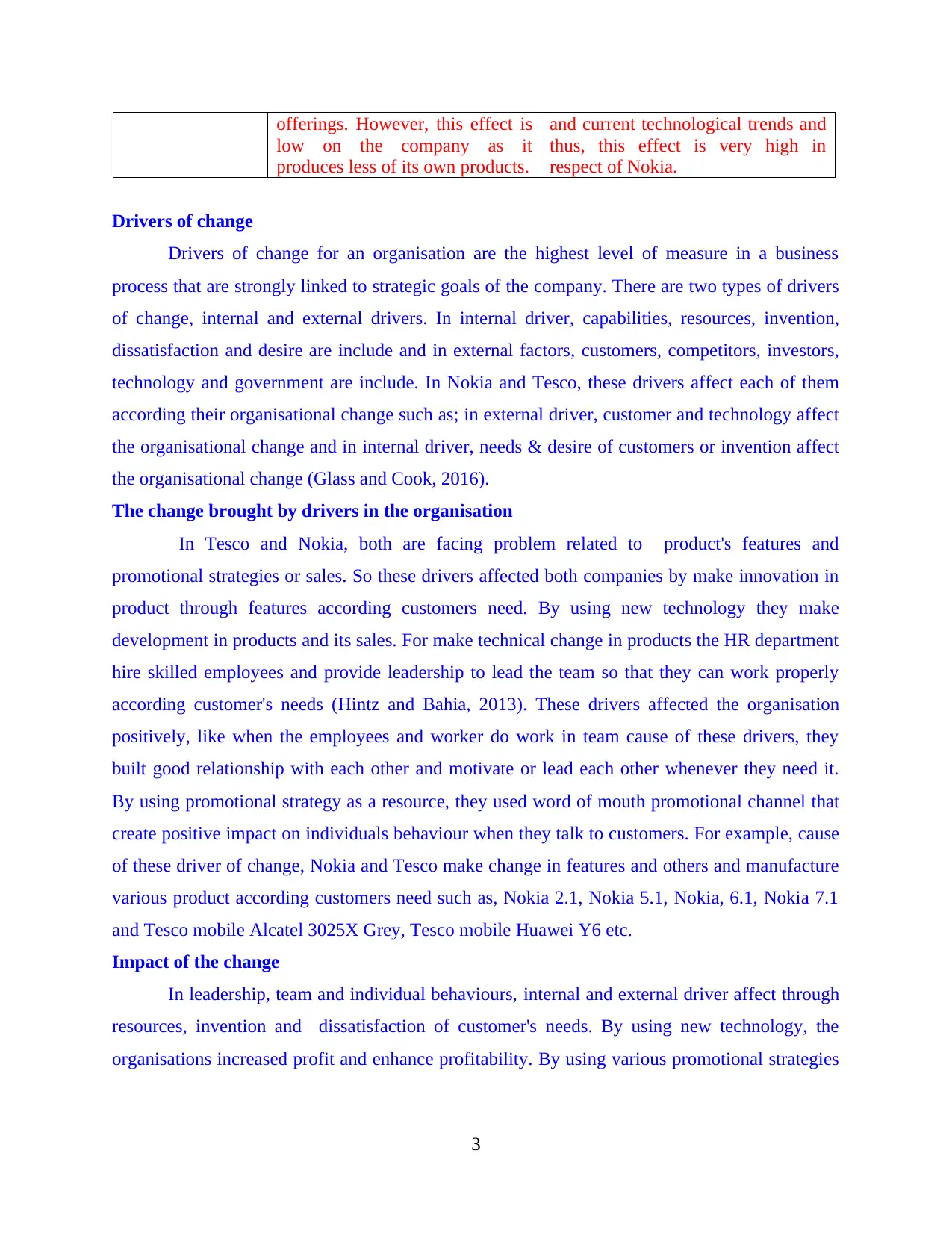
offerings. However, this effect is
low on the company as it
produces less of its own products.
and current technological trends and
thus, this effect is very high in
respect of Nokia.
Drivers of change
Drivers of change for an organisation are the highest level of measure in a business
process that are strongly linked to strategic goals of the company. There are two types of drivers
of change, internal and external drivers. In internal driver, capabilities, resources, invention,
dissatisfaction and desire are include and in external factors, customers, competitors, investors,
technology and government are include. In Nokia and Tesco, these drivers affect each of them
according their organisational change such as; in external driver, customer and technology affect
the organisational change and in internal driver, needs & desire of customers or invention affect
the organisational change (Glass and Cook, 2016).
The change brought by drivers in the organisation
In Tesco and Nokia, both are facing problem related to product's features and
promotional strategies or sales. So these drivers affected both companies by make innovation in
product through features according customers need. By using new technology they make
development in products and its sales. For make technical change in products the HR department
hire skilled employees and provide leadership to lead the team so that they can work properly
according customer's needs (Hintz and Bahia, 2013). These drivers affected the organisation
positively, like when the employees and worker do work in team cause of these drivers, they
built good relationship with each other and motivate or lead each other whenever they need it.
By using promotional strategy as a resource, they used word of mouth promotional channel that
create positive impact on individuals behaviour when they talk to customers. For example, cause
of these driver of change, Nokia and Tesco make change in features and others and manufacture
various product according customers need such as, Nokia 2.1, Nokia 5.1, Nokia, 6.1, Nokia 7.1
and Tesco mobile Alcatel 3025X Grey, Tesco mobile Huawei Y6 etc.
Impact of the change
In leadership, team and individual behaviours, internal and external driver affect through
resources, invention and dissatisfaction of customer's needs. By using new technology, the
organisations increased profit and enhance profitability. By using various promotional strategies
3
low on the company as it
produces less of its own products.
and current technological trends and
thus, this effect is very high in
respect of Nokia.
Drivers of change
Drivers of change for an organisation are the highest level of measure in a business
process that are strongly linked to strategic goals of the company. There are two types of drivers
of change, internal and external drivers. In internal driver, capabilities, resources, invention,
dissatisfaction and desire are include and in external factors, customers, competitors, investors,
technology and government are include. In Nokia and Tesco, these drivers affect each of them
according their organisational change such as; in external driver, customer and technology affect
the organisational change and in internal driver, needs & desire of customers or invention affect
the organisational change (Glass and Cook, 2016).
The change brought by drivers in the organisation
In Tesco and Nokia, both are facing problem related to product's features and
promotional strategies or sales. So these drivers affected both companies by make innovation in
product through features according customers need. By using new technology they make
development in products and its sales. For make technical change in products the HR department
hire skilled employees and provide leadership to lead the team so that they can work properly
according customer's needs (Hintz and Bahia, 2013). These drivers affected the organisation
positively, like when the employees and worker do work in team cause of these drivers, they
built good relationship with each other and motivate or lead each other whenever they need it.
By using promotional strategy as a resource, they used word of mouth promotional channel that
create positive impact on individuals behaviour when they talk to customers. For example, cause
of these driver of change, Nokia and Tesco make change in features and others and manufacture
various product according customers need such as, Nokia 2.1, Nokia 5.1, Nokia, 6.1, Nokia 7.1
and Tesco mobile Alcatel 3025X Grey, Tesco mobile Huawei Y6 etc.
Impact of the change
In leadership, team and individual behaviours, internal and external driver affect through
resources, invention and dissatisfaction of customer's needs. By using new technology, the
organisations increased profit and enhance profitability. By using various promotional strategies
3
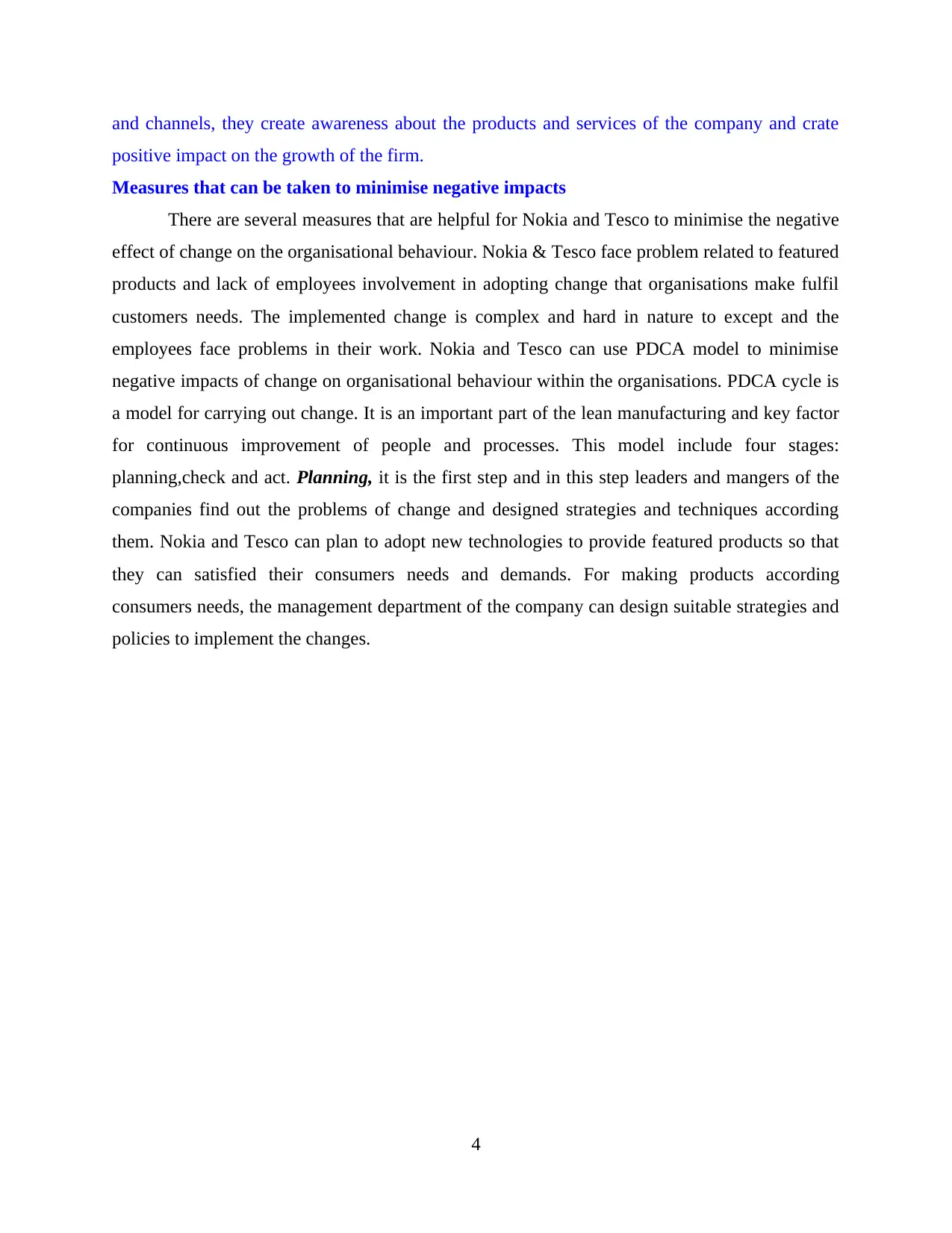
and channels, they create awareness about the products and services of the company and crate
positive impact on the growth of the firm.
Measures that can be taken to minimise negative impacts
There are several measures that are helpful for Nokia and Tesco to minimise the negative
effect of change on the organisational behaviour. Nokia & Tesco face problem related to featured
products and lack of employees involvement in adopting change that organisations make fulfil
customers needs. The implemented change is complex and hard in nature to except and the
employees face problems in their work. Nokia and Tesco can use PDCA model to minimise
negative impacts of change on organisational behaviour within the organisations. PDCA cycle is
a model for carrying out change. It is an important part of the lean manufacturing and key factor
for continuous improvement of people and processes. This model include four stages:
planning,check and act. Planning, it is the first step and in this step leaders and mangers of the
companies find out the problems of change and designed strategies and techniques according
them. Nokia and Tesco can plan to adopt new technologies to provide featured products so that
they can satisfied their consumers needs and demands. For making products according
consumers needs, the management department of the company can design suitable strategies and
policies to implement the changes.
4
positive impact on the growth of the firm.
Measures that can be taken to minimise negative impacts
There are several measures that are helpful for Nokia and Tesco to minimise the negative
effect of change on the organisational behaviour. Nokia & Tesco face problem related to featured
products and lack of employees involvement in adopting change that organisations make fulfil
customers needs. The implemented change is complex and hard in nature to except and the
employees face problems in their work. Nokia and Tesco can use PDCA model to minimise
negative impacts of change on organisational behaviour within the organisations. PDCA cycle is
a model for carrying out change. It is an important part of the lean manufacturing and key factor
for continuous improvement of people and processes. This model include four stages:
planning,check and act. Planning, it is the first step and in this step leaders and mangers of the
companies find out the problems of change and designed strategies and techniques according
them. Nokia and Tesco can plan to adopt new technologies to provide featured products so that
they can satisfied their consumers needs and demands. For making products according
consumers needs, the management department of the company can design suitable strategies and
policies to implement the changes.
4
⊘ This is a preview!⊘
Do you want full access?
Subscribe today to unlock all pages.

Trusted by 1+ million students worldwide
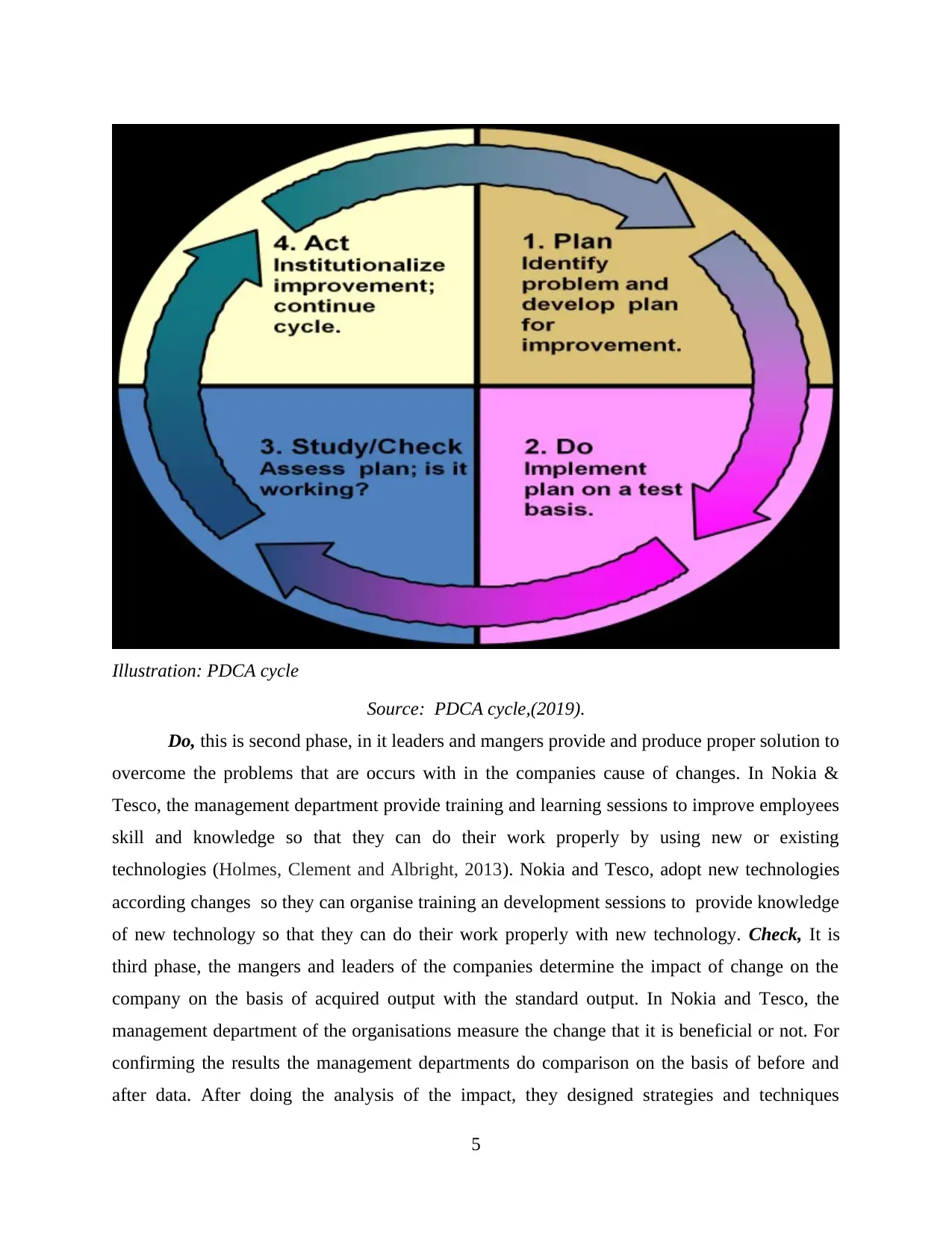
Source: PDCA cycle,(2019).
Do, this is second phase, in it leaders and mangers provide and produce proper solution to
overcome the problems that are occurs with in the companies cause of changes. In Nokia &
Tesco, the management department provide training and learning sessions to improve employees
skill and knowledge so that they can do their work properly by using new or existing
technologies (Holmes, Clement and Albright, 2013). Nokia and Tesco, adopt new technologies
according changes so they can organise training an development sessions to provide knowledge
of new technology so that they can do their work properly with new technology. Check, It is
third phase, the mangers and leaders of the companies determine the impact of change on the
company on the basis of acquired output with the standard output. In Nokia and Tesco, the
management department of the organisations measure the change that it is beneficial or not. For
confirming the results the management departments do comparison on the basis of before and
after data. After doing the analysis of the impact, they designed strategies and techniques
5
Illustration: PDCA cycle
Do, this is second phase, in it leaders and mangers provide and produce proper solution to
overcome the problems that are occurs with in the companies cause of changes. In Nokia &
Tesco, the management department provide training and learning sessions to improve employees
skill and knowledge so that they can do their work properly by using new or existing
technologies (Holmes, Clement and Albright, 2013). Nokia and Tesco, adopt new technologies
according changes so they can organise training an development sessions to provide knowledge
of new technology so that they can do their work properly with new technology. Check, It is
third phase, the mangers and leaders of the companies determine the impact of change on the
company on the basis of acquired output with the standard output. In Nokia and Tesco, the
management department of the organisations measure the change that it is beneficial or not. For
confirming the results the management departments do comparison on the basis of before and
after data. After doing the analysis of the impact, they designed strategies and techniques
5
Illustration: PDCA cycle
Paraphrase This Document
Need a fresh take? Get an instant paraphrase of this document with our AI Paraphraser
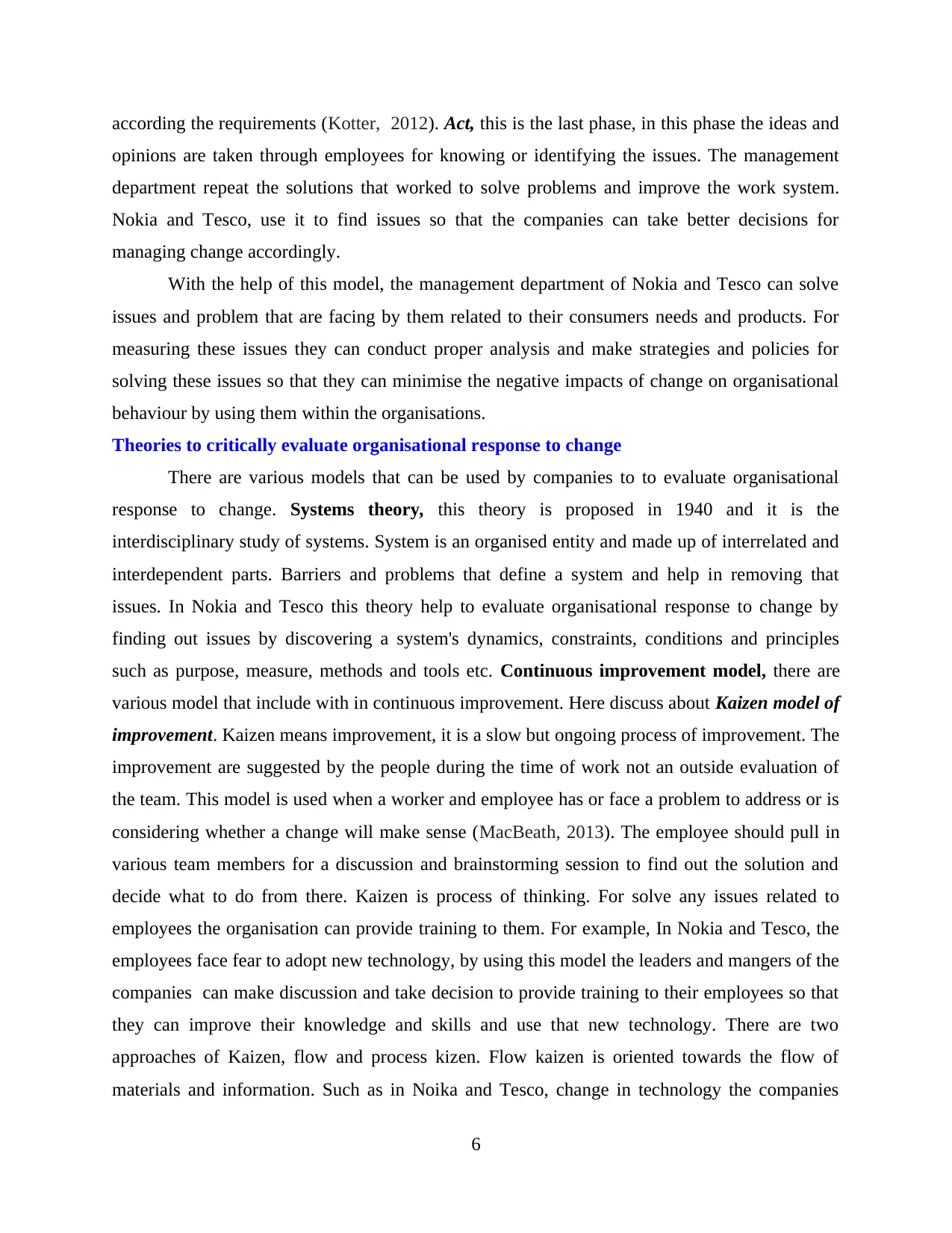
according the requirements (Kotter, 2012). Act, this is the last phase, in this phase the ideas and
opinions are taken through employees for knowing or identifying the issues. The management
department repeat the solutions that worked to solve problems and improve the work system.
Nokia and Tesco, use it to find issues so that the companies can take better decisions for
managing change accordingly.
With the help of this model, the management department of Nokia and Tesco can solve
issues and problem that are facing by them related to their consumers needs and products. For
measuring these issues they can conduct proper analysis and make strategies and policies for
solving these issues so that they can minimise the negative impacts of change on organisational
behaviour by using them within the organisations.
Theories to critically evaluate organisational response to change
There are various models that can be used by companies to to evaluate organisational
response to change. Systems theory, this theory is proposed in 1940 and it is the
interdisciplinary study of systems. System is an organised entity and made up of interrelated and
interdependent parts. Barriers and problems that define a system and help in removing that
issues. In Nokia and Tesco this theory help to evaluate organisational response to change by
finding out issues by discovering a system's dynamics, constraints, conditions and principles
such as purpose, measure, methods and tools etc. Continuous improvement model, there are
various model that include with in continuous improvement. Here discuss about Kaizen model of
improvement. Kaizen means improvement, it is a slow but ongoing process of improvement. The
improvement are suggested by the people during the time of work not an outside evaluation of
the team. This model is used when a worker and employee has or face a problem to address or is
considering whether a change will make sense (MacBeath, 2013). The employee should pull in
various team members for a discussion and brainstorming session to find out the solution and
decide what to do from there. Kaizen is process of thinking. For solve any issues related to
employees the organisation can provide training to them. For example, In Nokia and Tesco, the
employees face fear to adopt new technology, by using this model the leaders and mangers of the
companies can make discussion and take decision to provide training to their employees so that
they can improve their knowledge and skills and use that new technology. There are two
approaches of Kaizen, flow and process kizen. Flow kaizen is oriented towards the flow of
materials and information. Such as in Noika and Tesco, change in technology the companies
6
opinions are taken through employees for knowing or identifying the issues. The management
department repeat the solutions that worked to solve problems and improve the work system.
Nokia and Tesco, use it to find issues so that the companies can take better decisions for
managing change accordingly.
With the help of this model, the management department of Nokia and Tesco can solve
issues and problem that are facing by them related to their consumers needs and products. For
measuring these issues they can conduct proper analysis and make strategies and policies for
solving these issues so that they can minimise the negative impacts of change on organisational
behaviour by using them within the organisations.
Theories to critically evaluate organisational response to change
There are various models that can be used by companies to to evaluate organisational
response to change. Systems theory, this theory is proposed in 1940 and it is the
interdisciplinary study of systems. System is an organised entity and made up of interrelated and
interdependent parts. Barriers and problems that define a system and help in removing that
issues. In Nokia and Tesco this theory help to evaluate organisational response to change by
finding out issues by discovering a system's dynamics, constraints, conditions and principles
such as purpose, measure, methods and tools etc. Continuous improvement model, there are
various model that include with in continuous improvement. Here discuss about Kaizen model of
improvement. Kaizen means improvement, it is a slow but ongoing process of improvement. The
improvement are suggested by the people during the time of work not an outside evaluation of
the team. This model is used when a worker and employee has or face a problem to address or is
considering whether a change will make sense (MacBeath, 2013). The employee should pull in
various team members for a discussion and brainstorming session to find out the solution and
decide what to do from there. Kaizen is process of thinking. For solve any issues related to
employees the organisation can provide training to them. For example, In Nokia and Tesco, the
employees face fear to adopt new technology, by using this model the leaders and mangers of the
companies can make discussion and take decision to provide training to their employees so that
they can improve their knowledge and skills and use that new technology. There are two
approaches of Kaizen, flow and process kizen. Flow kaizen is oriented towards the flow of
materials and information. Such as in Noika and Tesco, change in technology the companies
6
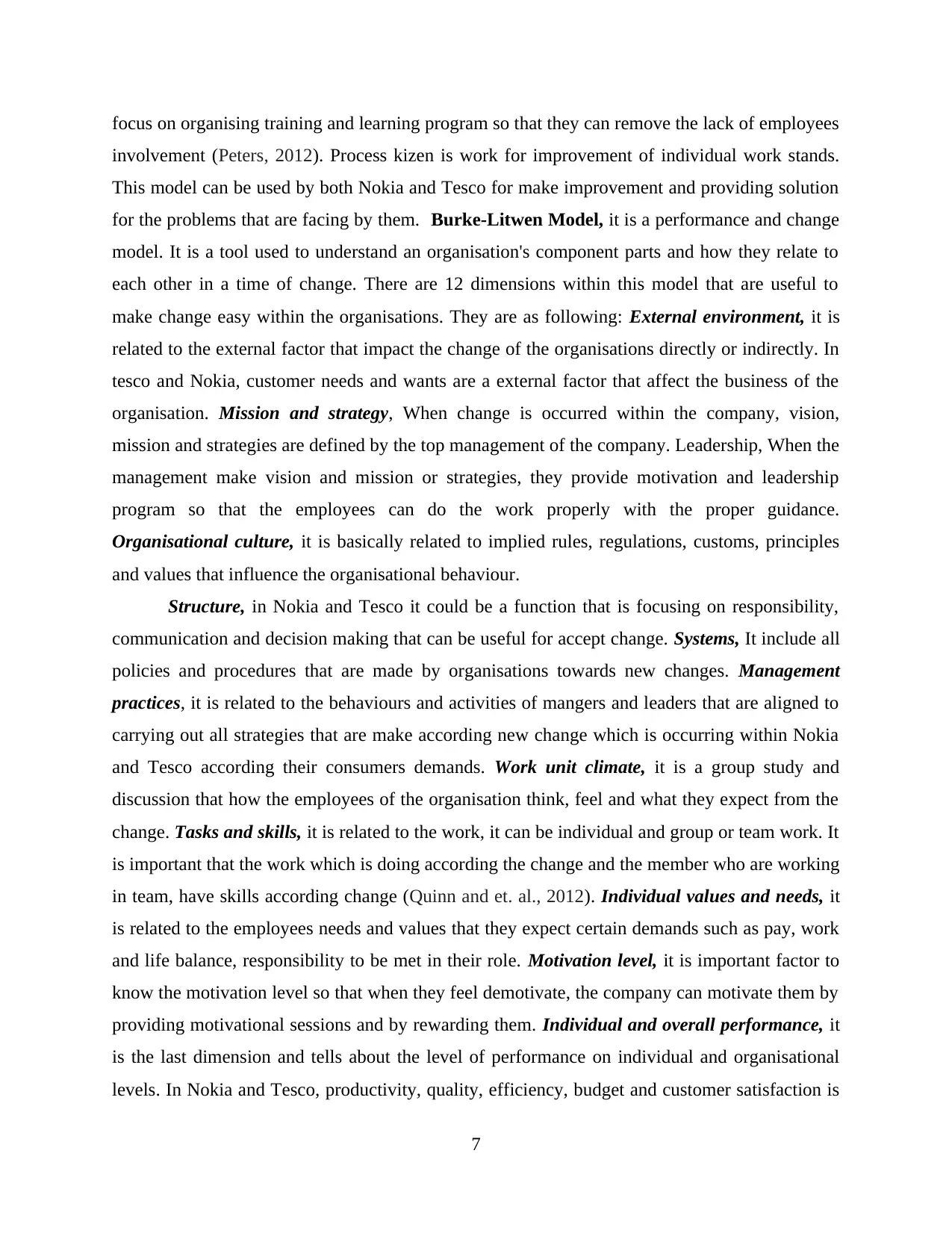
focus on organising training and learning program so that they can remove the lack of employees
involvement (Peters, 2012). Process kizen is work for improvement of individual work stands.
This model can be used by both Nokia and Tesco for make improvement and providing solution
for the problems that are facing by them. Burke-Litwen Model, it is a performance and change
model. It is a tool used to understand an organisation's component parts and how they relate to
each other in a time of change. There are 12 dimensions within this model that are useful to
make change easy within the organisations. They are as following: External environment, it is
related to the external factor that impact the change of the organisations directly or indirectly. In
tesco and Nokia, customer needs and wants are a external factor that affect the business of the
organisation. Mission and strategy, When change is occurred within the company, vision,
mission and strategies are defined by the top management of the company. Leadership, When the
management make vision and mission or strategies, they provide motivation and leadership
program so that the employees can do the work properly with the proper guidance.
Organisational culture, it is basically related to implied rules, regulations, customs, principles
and values that influence the organisational behaviour.
Structure, in Nokia and Tesco it could be a function that is focusing on responsibility,
communication and decision making that can be useful for accept change. Systems, It include all
policies and procedures that are made by organisations towards new changes. Management
practices, it is related to the behaviours and activities of mangers and leaders that are aligned to
carrying out all strategies that are make according new change which is occurring within Nokia
and Tesco according their consumers demands. Work unit climate, it is a group study and
discussion that how the employees of the organisation think, feel and what they expect from the
change. Tasks and skills, it is related to the work, it can be individual and group or team work. It
is important that the work which is doing according the change and the member who are working
in team, have skills according change (Quinn and et. al., 2012). Individual values and needs, it
is related to the employees needs and values that they expect certain demands such as pay, work
and life balance, responsibility to be met in their role. Motivation level, it is important factor to
know the motivation level so that when they feel demotivate, the company can motivate them by
providing motivational sessions and by rewarding them. Individual and overall performance, it
is the last dimension and tells about the level of performance on individual and organisational
levels. In Nokia and Tesco, productivity, quality, efficiency, budget and customer satisfaction is
7
involvement (Peters, 2012). Process kizen is work for improvement of individual work stands.
This model can be used by both Nokia and Tesco for make improvement and providing solution
for the problems that are facing by them. Burke-Litwen Model, it is a performance and change
model. It is a tool used to understand an organisation's component parts and how they relate to
each other in a time of change. There are 12 dimensions within this model that are useful to
make change easy within the organisations. They are as following: External environment, it is
related to the external factor that impact the change of the organisations directly or indirectly. In
tesco and Nokia, customer needs and wants are a external factor that affect the business of the
organisation. Mission and strategy, When change is occurred within the company, vision,
mission and strategies are defined by the top management of the company. Leadership, When the
management make vision and mission or strategies, they provide motivation and leadership
program so that the employees can do the work properly with the proper guidance.
Organisational culture, it is basically related to implied rules, regulations, customs, principles
and values that influence the organisational behaviour.
Structure, in Nokia and Tesco it could be a function that is focusing on responsibility,
communication and decision making that can be useful for accept change. Systems, It include all
policies and procedures that are made by organisations towards new changes. Management
practices, it is related to the behaviours and activities of mangers and leaders that are aligned to
carrying out all strategies that are make according new change which is occurring within Nokia
and Tesco according their consumers demands. Work unit climate, it is a group study and
discussion that how the employees of the organisation think, feel and what they expect from the
change. Tasks and skills, it is related to the work, it can be individual and group or team work. It
is important that the work which is doing according the change and the member who are working
in team, have skills according change (Quinn and et. al., 2012). Individual values and needs, it
is related to the employees needs and values that they expect certain demands such as pay, work
and life balance, responsibility to be met in their role. Motivation level, it is important factor to
know the motivation level so that when they feel demotivate, the company can motivate them by
providing motivational sessions and by rewarding them. Individual and overall performance, it
is the last dimension and tells about the level of performance on individual and organisational
levels. In Nokia and Tesco, productivity, quality, efficiency, budget and customer satisfaction is
7
⊘ This is a preview!⊘
Do you want full access?
Subscribe today to unlock all pages.

Trusted by 1+ million students worldwide
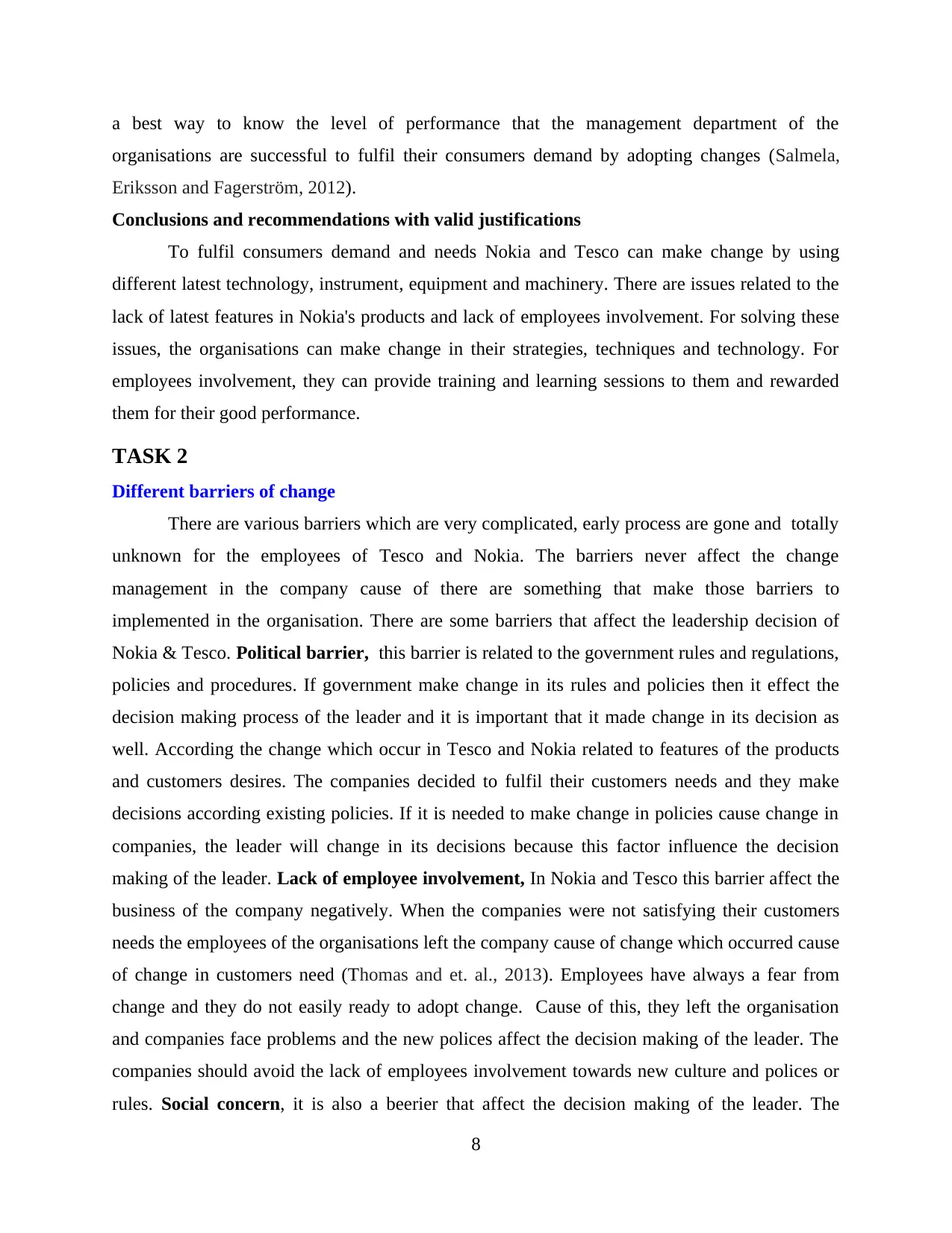
a best way to know the level of performance that the management department of the
organisations are successful to fulfil their consumers demand by adopting changes (Salmela,
Eriksson and Fagerström, 2012).
Conclusions and recommendations with valid justifications
To fulfil consumers demand and needs Nokia and Tesco can make change by using
different latest technology, instrument, equipment and machinery. There are issues related to the
lack of latest features in Nokia's products and lack of employees involvement. For solving these
issues, the organisations can make change in their strategies, techniques and technology. For
employees involvement, they can provide training and learning sessions to them and rewarded
them for their good performance.
TASK 2
Different barriers of change
There are various barriers which are very complicated, early process are gone and totally
unknown for the employees of Tesco and Nokia. The barriers never affect the change
management in the company cause of there are something that make those barriers to
implemented in the organisation. There are some barriers that affect the leadership decision of
Nokia & Tesco. Political barrier, this barrier is related to the government rules and regulations,
policies and procedures. If government make change in its rules and policies then it effect the
decision making process of the leader and it is important that it made change in its decision as
well. According the change which occur in Tesco and Nokia related to features of the products
and customers desires. The companies decided to fulfil their customers needs and they make
decisions according existing policies. If it is needed to make change in policies cause change in
companies, the leader will change in its decisions because this factor influence the decision
making of the leader. Lack of employee involvement, In Nokia and Tesco this barrier affect the
business of the company negatively. When the companies were not satisfying their customers
needs the employees of the organisations left the company cause of change which occurred cause
of change in customers need (Thomas and et. al., 2013). Employees have always a fear from
change and they do not easily ready to adopt change. Cause of this, they left the organisation
and companies face problems and the new polices affect the decision making of the leader. The
companies should avoid the lack of employees involvement towards new culture and polices or
rules. Social concern, it is also a beerier that affect the decision making of the leader. The
8
organisations are successful to fulfil their consumers demand by adopting changes (Salmela,
Eriksson and Fagerström, 2012).
Conclusions and recommendations with valid justifications
To fulfil consumers demand and needs Nokia and Tesco can make change by using
different latest technology, instrument, equipment and machinery. There are issues related to the
lack of latest features in Nokia's products and lack of employees involvement. For solving these
issues, the organisations can make change in their strategies, techniques and technology. For
employees involvement, they can provide training and learning sessions to them and rewarded
them for their good performance.
TASK 2
Different barriers of change
There are various barriers which are very complicated, early process are gone and totally
unknown for the employees of Tesco and Nokia. The barriers never affect the change
management in the company cause of there are something that make those barriers to
implemented in the organisation. There are some barriers that affect the leadership decision of
Nokia & Tesco. Political barrier, this barrier is related to the government rules and regulations,
policies and procedures. If government make change in its rules and policies then it effect the
decision making process of the leader and it is important that it made change in its decision as
well. According the change which occur in Tesco and Nokia related to features of the products
and customers desires. The companies decided to fulfil their customers needs and they make
decisions according existing policies. If it is needed to make change in policies cause change in
companies, the leader will change in its decisions because this factor influence the decision
making of the leader. Lack of employee involvement, In Nokia and Tesco this barrier affect the
business of the company negatively. When the companies were not satisfying their customers
needs the employees of the organisations left the company cause of change which occurred cause
of change in customers need (Thomas and et. al., 2013). Employees have always a fear from
change and they do not easily ready to adopt change. Cause of this, they left the organisation
and companies face problems and the new polices affect the decision making of the leader. The
companies should avoid the lack of employees involvement towards new culture and polices or
rules. Social concern, it is also a beerier that affect the decision making of the leader. The
8
Paraphrase This Document
Need a fresh take? Get an instant paraphrase of this document with our AI Paraphraser
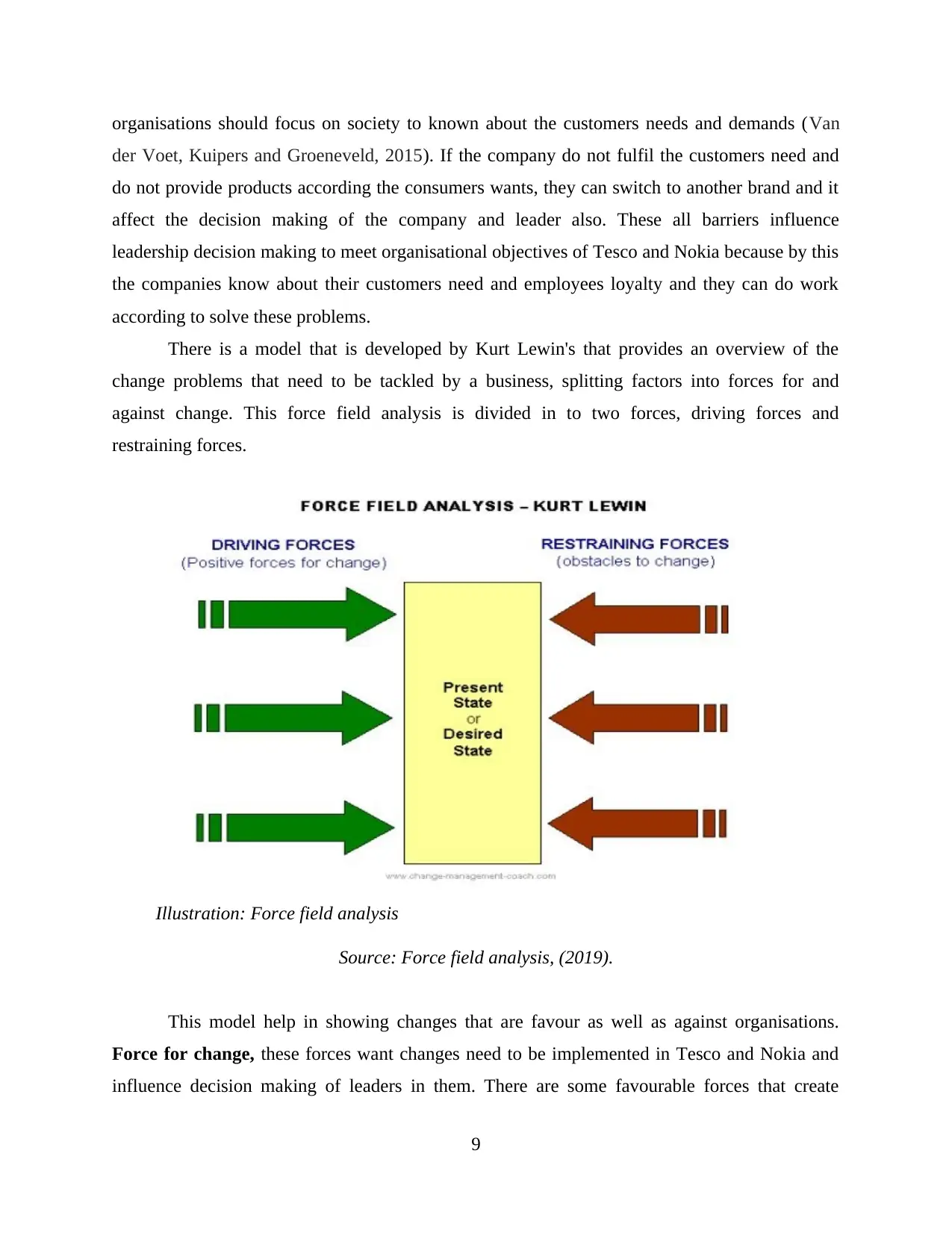
organisations should focus on society to known about the customers needs and demands (Van
der Voet, Kuipers and Groeneveld, 2015). If the company do not fulfil the customers need and
do not provide products according the consumers wants, they can switch to another brand and it
affect the decision making of the company and leader also. These all barriers influence
leadership decision making to meet organisational objectives of Tesco and Nokia because by this
the companies know about their customers need and employees loyalty and they can do work
according to solve these problems.
There is a model that is developed by Kurt Lewin's that provides an overview of the
change problems that need to be tackled by a business, splitting factors into forces for and
against change. This force field analysis is divided in to two forces, driving forces and
restraining forces.
Source: Force field analysis, (2019).
This model help in showing changes that are favour as well as against organisations.
Force for change, these forces want changes need to be implemented in Tesco and Nokia and
influence decision making of leaders in them. There are some favourable forces that create
9
Illustration: Force field analysis
der Voet, Kuipers and Groeneveld, 2015). If the company do not fulfil the customers need and
do not provide products according the consumers wants, they can switch to another brand and it
affect the decision making of the company and leader also. These all barriers influence
leadership decision making to meet organisational objectives of Tesco and Nokia because by this
the companies know about their customers need and employees loyalty and they can do work
according to solve these problems.
There is a model that is developed by Kurt Lewin's that provides an overview of the
change problems that need to be tackled by a business, splitting factors into forces for and
against change. This force field analysis is divided in to two forces, driving forces and
restraining forces.
Source: Force field analysis, (2019).
This model help in showing changes that are favour as well as against organisations.
Force for change, these forces want changes need to be implemented in Tesco and Nokia and
influence decision making of leaders in them. There are some favourable forces that create
9
Illustration: Force field analysis
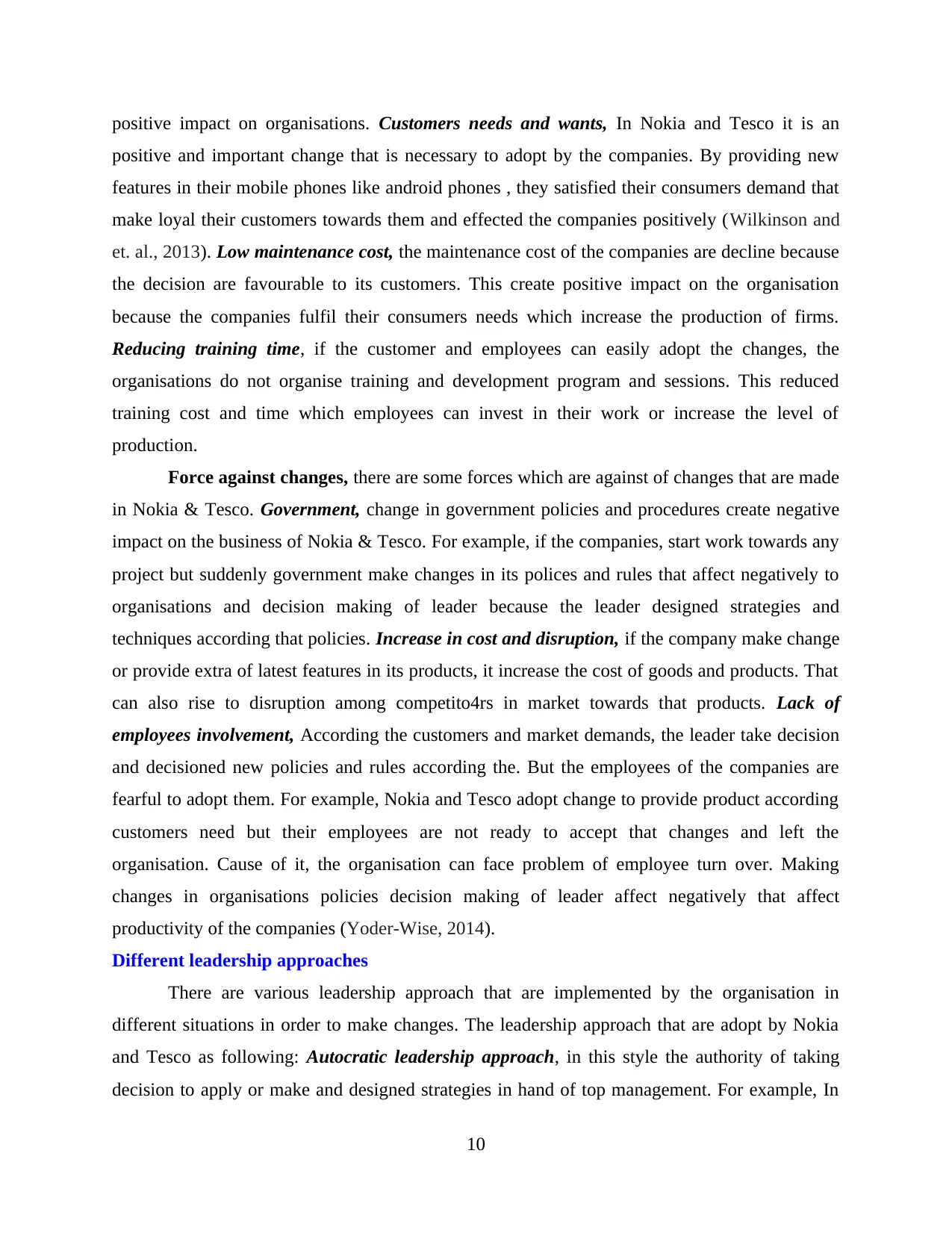
positive impact on organisations. Customers needs and wants, In Nokia and Tesco it is an
positive and important change that is necessary to adopt by the companies. By providing new
features in their mobile phones like android phones , they satisfied their consumers demand that
make loyal their customers towards them and effected the companies positively (Wilkinson and
et. al., 2013). Low maintenance cost, the maintenance cost of the companies are decline because
the decision are favourable to its customers. This create positive impact on the organisation
because the companies fulfil their consumers needs which increase the production of firms.
Reducing training time, if the customer and employees can easily adopt the changes, the
organisations do not organise training and development program and sessions. This reduced
training cost and time which employees can invest in their work or increase the level of
production.
Force against changes, there are some forces which are against of changes that are made
in Nokia & Tesco. Government, change in government policies and procedures create negative
impact on the business of Nokia & Tesco. For example, if the companies, start work towards any
project but suddenly government make changes in its polices and rules that affect negatively to
organisations and decision making of leader because the leader designed strategies and
techniques according that policies. Increase in cost and disruption, if the company make change
or provide extra of latest features in its products, it increase the cost of goods and products. That
can also rise to disruption among competito4rs in market towards that products. Lack of
employees involvement, According the customers and market demands, the leader take decision
and decisioned new policies and rules according the. But the employees of the companies are
fearful to adopt them. For example, Nokia and Tesco adopt change to provide product according
customers need but their employees are not ready to accept that changes and left the
organisation. Cause of it, the organisation can face problem of employee turn over. Making
changes in organisations policies decision making of leader affect negatively that affect
productivity of the companies (Yoder-Wise, 2014).
Different leadership approaches
There are various leadership approach that are implemented by the organisation in
different situations in order to make changes. The leadership approach that are adopt by Nokia
and Tesco as following: Autocratic leadership approach, in this style the authority of taking
decision to apply or make and designed strategies in hand of top management. For example, In
10
positive and important change that is necessary to adopt by the companies. By providing new
features in their mobile phones like android phones , they satisfied their consumers demand that
make loyal their customers towards them and effected the companies positively (Wilkinson and
et. al., 2013). Low maintenance cost, the maintenance cost of the companies are decline because
the decision are favourable to its customers. This create positive impact on the organisation
because the companies fulfil their consumers needs which increase the production of firms.
Reducing training time, if the customer and employees can easily adopt the changes, the
organisations do not organise training and development program and sessions. This reduced
training cost and time which employees can invest in their work or increase the level of
production.
Force against changes, there are some forces which are against of changes that are made
in Nokia & Tesco. Government, change in government policies and procedures create negative
impact on the business of Nokia & Tesco. For example, if the companies, start work towards any
project but suddenly government make changes in its polices and rules that affect negatively to
organisations and decision making of leader because the leader designed strategies and
techniques according that policies. Increase in cost and disruption, if the company make change
or provide extra of latest features in its products, it increase the cost of goods and products. That
can also rise to disruption among competito4rs in market towards that products. Lack of
employees involvement, According the customers and market demands, the leader take decision
and decisioned new policies and rules according the. But the employees of the companies are
fearful to adopt them. For example, Nokia and Tesco adopt change to provide product according
customers need but their employees are not ready to accept that changes and left the
organisation. Cause of it, the organisation can face problem of employee turn over. Making
changes in organisations policies decision making of leader affect negatively that affect
productivity of the companies (Yoder-Wise, 2014).
Different leadership approaches
There are various leadership approach that are implemented by the organisation in
different situations in order to make changes. The leadership approach that are adopt by Nokia
and Tesco as following: Autocratic leadership approach, in this style the authority of taking
decision to apply or make and designed strategies in hand of top management. For example, In
10
⊘ This is a preview!⊘
Do you want full access?
Subscribe today to unlock all pages.

Trusted by 1+ million students worldwide
1 out of 18
Related Documents
Your All-in-One AI-Powered Toolkit for Academic Success.
+13062052269
info@desklib.com
Available 24*7 on WhatsApp / Email
![[object Object]](/_next/static/media/star-bottom.7253800d.svg)
Unlock your academic potential
Copyright © 2020–2025 A2Z Services. All Rights Reserved. Developed and managed by ZUCOL.





